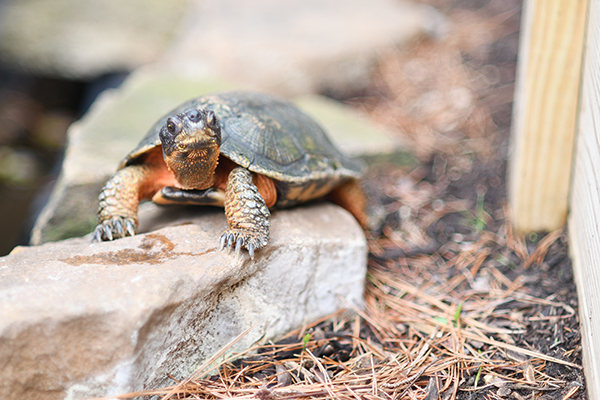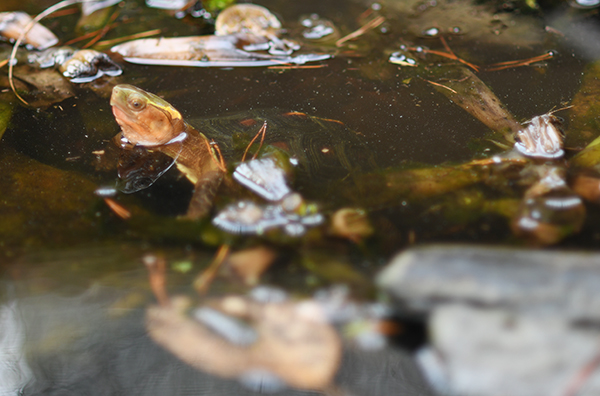News
Endangered Turtle Care Continues
03/25/20
 A few members of Roadrunner Nation are just beginning to wake up after being in hibernation since October.
A few members of Roadrunner Nation are just beginning to wake up after being in hibernation since October.
The Chinese golden-headed box turtles, Cuora flavomarginata, are starting to emerge after burying themselves in mud for the winter. They are one of endangered turtle species housed at Dalton State in the Turtle Assurance Colony (TAC).
Between TAC and the Saving Animals from Extinction (SAFE) programs there are more than 150 turtles and 15 species. Both programs are designed to ensure the species survive by encouraging breeding.
Even with the regulations to move to remote learning this semester due to the Coronavirus (COVID-19), the endangered turtles still need care. In order to help prevent the spread of the virus, faculty members and student volunteers go to campus one at a time to care for the animals and sterilize work spaces each time.
Research on the animals and attempts to encourage breeding have been temporarily suspended so all focus can be on caring for the animal’s immediate needs, said Chris Manis, assistant professor of biology and curator of the turtle programs.
“The turtles must be taken care of daily,” he said. “My focus right now is on keeping them fed, making sure they’re healthy and that their habitats are clean. I’m also watching the Cuora flavormarginata to make sure they all come up out of hibernation. Because they’re all in one enclosure, breeding may still happen, but it’s not where my focus is right now.”
Brittany Flood, a biology major expected to graduate this spring, works with juvenile turtles in the TAC. Still being able to care for the animals during this uncertain time is invaluable to her.
 “It means a lot to be able to help with TAC during such a tumultuous time,” she said. “The animals depend on us, and keeping our animals healthy and taken care of not only benefits them but their entire species worldwide since they are endangered. Keeping our Dalton State animals healthy is a way for me to feel like I’m helping turtles all over the world and therefore benefiting everyone. It gives me hope people can work together, and we can get through this time.”
“It means a lot to be able to help with TAC during such a tumultuous time,” she said. “The animals depend on us, and keeping our animals healthy and taken care of not only benefits them but their entire species worldwide since they are endangered. Keeping our Dalton State animals healthy is a way for me to feel like I’m helping turtles all over the world and therefore benefiting everyone. It gives me hope people can work together, and we can get through this time.”
Being involved with TAC has helped Flood learn to manage her time better, while also learning more about morphometrics – documenting individual turtle’s weight and shell measurements – and caring for freshly laid eggs.
“It’s important to know how to notice nesting behavior and be able to safely dig up the eggs without damaging them,” Flood said. “You have to keep them flat and not turn them after they are laid or it could kill the baby turtle.”
The North American wood turtles, Glyptemys insculpta, are also emerging from their hibernation. That species is part of SAFE, which is a program with specific plans to reintroduce turtles to their natural habitats.
TAC, which is part of the global Turtle Survival Alliance (TSA) efforts, does not yet have a specific plan to reintroduce turtles to their natural habitats but is looking at reintroducing species to historical ranges. The TSA is a conservation group dedicated to the conservation of endangered and threatened turtle and tortoise species worldwide.
“Many of those turtles are in danger of extinction because other cultures consume the turtles without regards to conservation,” Manis said. “Worldwide the behavior hasn’t stopped. SAFE is different because those turtles are native to areas that have stricter laws and more regularly enforce activities like poaching.”
Dalton State began TAC in 2014 and has successfully bred endangered species several times, including Serrated hinge-back tortoises, Kinixys erosa. Dalton State was one of the first worldwide to successfully breed that species.
The college became involved with SAFE just last semester.
Working with the turtles gives students hands-on husbandry experience and an opportunity for research. It has led many students to internships and positions at research facilities, aquariums and zoos. Flood plans to enter conservation or wildlife biology and pursue a master’s degree in conservation biology or herpetology.
